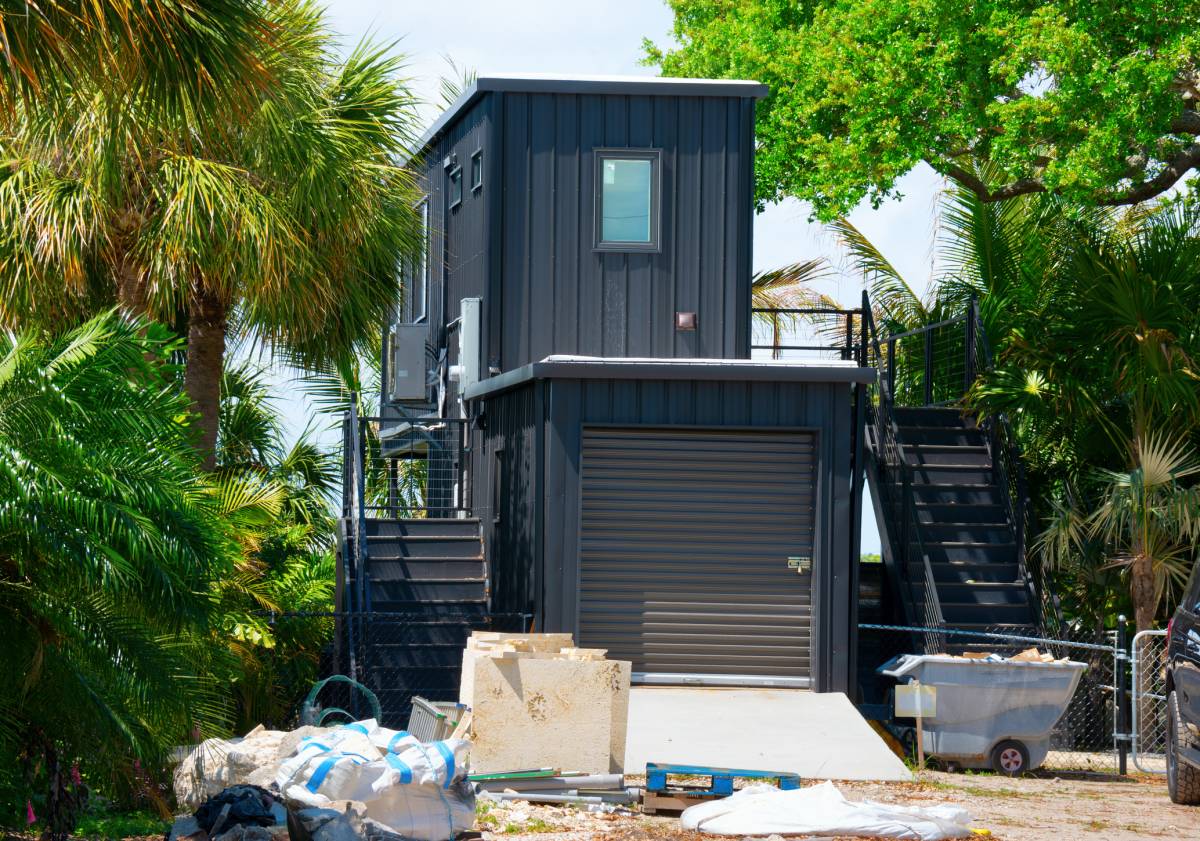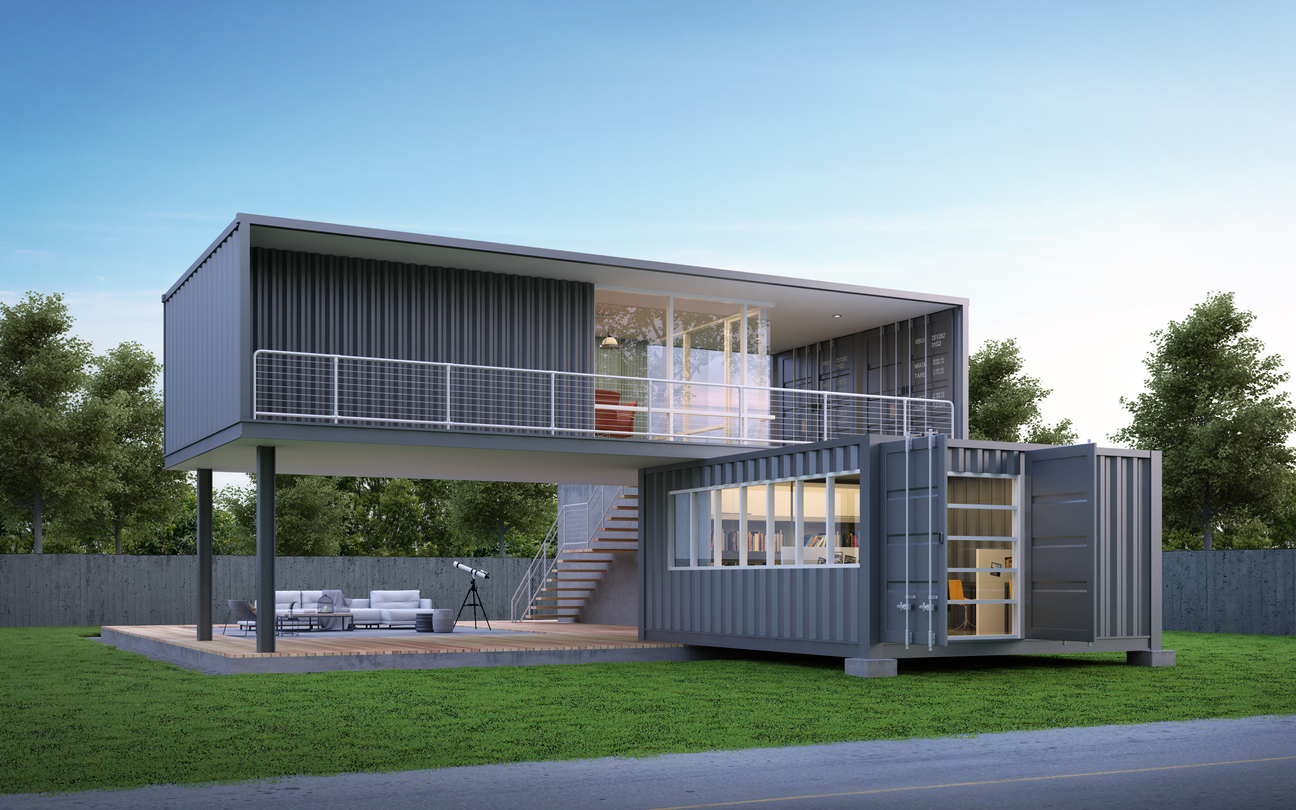- Oneflare /
- Cost Guides /
- Shipping Container Homes

How Much Does a Shipping Container Home Cost?
$30,000 - $275,000
What's on this page
- Cost of a shipping container home
- What is a shipping container home?
- Shipping container homes cost by size
- Shipping container labour cost
- Benefits of building a shipping container home
- Factors impacting shipping home cost
- Shipping container home regulations
- Hiring a Builder
- FAQs on shipping container homes
Read Related Shipping Container Home Articles
How much do shipping container homes cost?
Shipping containers, traditionally known as cargo transportation containers, have found new applications beyond their original use. These containers are now used in residential and commercial architecture as a unique, sustainable, and cost-effective space where people can freely live or work. Shipping container homes costs between $30,000 to $200,000 or higher for ready-for-occupancy structures.
What are shipping container homes?
Shipping container homes are residential structures crafted from repurposed shipping containers, leveraging their inherent durability and weather resistance. These typically measure 20 to 40 feet long, with standard dimensions of 8 feet in height and width.
The 20-foot units cater to compact living, suitable for individual or minimalist arrangements. Meanwhile, the larger 40-foot containers are more spacious and versatile, often favoured for larger residences or multi-container configurations. As the popularity of container homes rises, innovative designs emerge, combining both variations to create unique and dynamic living spaces within a single structure.
Shipping container homes cost in Australia by size
| Size | Average Cost |
| 15m2 | $20,000 – $42,000 |
| 30ft | $50,000 – $71,000 |
| 50ft | $90,000+ |
The cost of a shipping container home is significantly influenced by its size. The size of a shipping container home could be measured in square metres or square feet, and as the footprint increases, so does the overall construction cost.
Larger homes that require more or bigger shipping containers, additional structural modifications, and increased amounts of materials contribute to a proportional rise in expenses.
Shipping container home average labour cost
| State | Average cost |
| Sydney | $30 – $65 |
| Melbourne | $35 – $70 |
| Brisbane | $30 – $65 |
| Canberra | $30 – $65 |
| Perth | $30 – $85 |
| Darwin | $30 – $80 |
| Hobart | $30 – $80 |
| Adelaide | $25 – $80 |
The price of labour when building container homes fluctuates depending on the region where it was built, as construction costs, labour rates, and material prices can differ between the Australian states.
Shipping container homes in metropolitan areas, like Sydney or Melbourne, will naturally have more expensive price tags attached to them compared to regional areas. Moreover, building regulations and permit fees can differ between states, impacting the overall budget.
Benefits of building a shipping container home
People choose shipping container homes for several reasons. Here are a few of the main advantages of building houses made from shipping containers.
Cost-effective
They are a cost-effective alternative when compared to frame construction. The cost of a shipping container home depends on the type of container chosen. A small 6-metre shipping container can cost as little as $1,400, and a 12-metre container only costs around $4,800.
Style
Style is where the cost can differ. You can choose something basic, or you can opt for luxury finishes. Some of the ones that are found on popular websites are quite luxurious. They can range from modern to rustic, as you wish.
Environmentally friendly
The shipping containers that are used for homes are ones that have been put out of service. They are still good enough to use for homes, but the company discards them. Building homes from them is a way of recycling them.
Improved construction time
The best part about building a shipping container home is that they can be stacked on top of each other using cranes. The basic structure can be up in as little as a day. It generally takes between four and ten weeks to build a larger home.
Weather-resistant
Shipping containers are made from durable metal, which is exceptionally tough. They will not be damaged as easily by hail or winds as regular wood-frame houses.
Lower ongoing costs
Maintenance costs are also lower. They do not need re-roofed, foundation repairs, or as much maintenance as wood-frame houses over the time of ownership.
Factors affecting shipping container house cost
 Image source: iStock
Image source: iStock
Many factors can influence how much shipping container homes cost to build, and here are some of them.
Size
The size of a shipping container home is a key player in the total cost and influences different aspects of the construction process. Larger container homes will escalate the upfront expenses of purchasing and transporting these units. Conversely, smaller container homes may save you some money at the expense of having limited living space.
Design
Design complexity is another thing worth noting if you’re looking to budget your finances throughout the project.
Intricate or unique designs demand higher engineering expertise and construction efforts, increasing overall expenses. When envisioning a container home, you should recognise that these design elements may pose additional costs during both the planning and execution phases.
Number of containers being used
Like how size plays a role in a larger project bill, so does the number of containers used in the project. Not only would these additions to your home involve a higher initial purchase, but they can also significantly impact modification costs should unexpected changes or accidents occur.
Shipping containers can cost roughly $2,000 and go well up to $20,000, depending on their size, material, and purpose. If you want to use these containers for residential purposes, prices can go higher depending on the desired build, size, and specifications.
Location
Location affects shipping container home prices in Australia. If it is located in a remote area, you can expect to pay more for transportation than if you chose to build closer to the material source. Areas located in business districts or metropolitan areas will inherently be more expensive than addresses in rural or less densely populated regions. Also, labour costs are different in some regions of the country.
Construction materials
Construction materials, like insulation, flooring, roofing, and exterior paint finishes, should be considered when talking about a shipping container home not only for their functional and aesthetic roles but also as integral contributors to the overall cost dynamics of the project.
Opting for energy-efficient insulation and durable flooring solutions may enhance comfort but typically come with a higher price tag. Likewise, selecting robust roofing materials and premium exterior finishes can improve the structure’s longevity and aesthetics but could potentially add to overall construction costs.
Requirements and regulations
Regulations regarding shipping container homes are different in every local government jurisdiction. Some local communities do not even allow shipping container homes. You must check with your local regulations before you embark on your shipping container home journey.
Some companies build pre-constructed homes, which can affect the price of a shipping container home. Due to meeting regulations, buying a pre-built one can be cheaper than doing it yourself.
Additional costs or hidden fees
The abovementioned costs might already be something homeowners are aware of and might have saved enough money for. However, it’s crucial to thoroughly review potential hidden costs and fees that could catch you off guard when you a build container home.
Specialised tools and equipment
Transporting shipping containers requires specialised equipment designed for heavy lifting and precise manoeuvring. Cranes and forklifts become essential for safely unloading containers from delivery trucks and accurately positioning them on the construction site.
The cost of renting or hiring these lifting devices can vary based on the size and weight of the containers and the complexity of the delivery and placement process.
Insurance and permits
Standard home insurance policies might not adequately address the unique aspects of container homes, such as modifications to the steel structure or the atypical design. Therefore, obtaining specialised insurance coverage should be a priority.
On top of insurance considerations, the permitting process for shipping container homes can present its own challenges. Homeowners may opt for expedited permitting to streamline the approval process, particularly if they have a specific timeline for construction.
Customisation costs
Personalised shipping containers or units modified to your liking may be subjected to higher costs. This includes structural changes, alterations like the exterior’s paint colours, or adding specific features. For a better-informed decision before renting, discuss these modifications and the subsequent costs they can have with your provider.
Delivery or pickup fees
Providers may calculate delivery fees based on the distance between their storage facility and your desired address. The size of the shipping container can affect transportation costs, especially if special equipment or services are required for delivery.
Shipping container home regulations in Australia
 Image source: iStock
Image source: iStock
If you plan to own a shipping container home in Australia, it’s important to consider the different rules and regulations based on your address’s zoning plan, building codes and standards, and council approval.
Planning and zoning regulations
Local councils enforce zoning regulations that dictate land use and permissible building types in specific areas. Before constructing a shipping container home, verify that the chosen location complies with the zoning regulations.
Some areas may restrict residential construction, while others may have specific requirements for alternative housing structures.
Council approval
Once you’re sure your location is fit for residential use, the next step is to obtain approval from your address’s local council. This process typically involves submitting detailed plans and documentation about the proposed shipping container home.
Building codes and standards
Australian building codes and standards set out the minimum requirements for construction to ensure safety, health, and sustainability. When building a shipping container home, it must comply with the relevant Building Code of Australia (BCA) requirements, as it provides guidelines for structural integrity, insulation, ventilation, and other aspects of construction.
Other special requirements and standards
Sometimes, containers might need structural modifications to pass the Australian building standards. As such, engineers are tapped to assess and certify these modifications to ensure they comply with the country’s safety regulations. The certification process typically involves an evaluation of the structural integrity of the container and any alterations made to it.
Homeowners are encouraged to engage with qualified electricians throughout the planning and construction phases. These professionals ensure that your container home meets electrical safety standards and can help with the design and installation process of lighting, wiring, and connections.
The same can be said for a shipping container home’s plumbing situation. Consult with your local plumber to design the plumbing system for your container home. They will consider the unique challenges and requirements of container construction, including limited space and the need for efficient water supply and wastewater management.
Helpful tips when hiring a container home builder
Opting to live in a shipping container home is no easy feat, and it can be a unique living situation compared to traditional homes or apartments. Thankfully, every step can be expertly guided by the right industry professionals, like builders and contractors, who make sure you can have a smooth and rewarding experience from start to finish.
Do your research
Before hiring a container home builder, ensure they have the right licences and qualifications to undertake construction projects in your area legally. Moreover, ensure that the professionals have specific experience and qualifications for container home construction.
Constructing homes from shipping containers involves unique challenges and considerations that may not be part of traditional construction practices. Do the same if you also plan to hire plumbers, electricians, or experts in home improvement.
Ask to review their portfolio and past works
To make sure the builder or developer’s design and style align with your vision for a shipping container home, it’s highly recommended to request a thorough review of their portfolio and past works.
This can give you valuable insights into their capabilities, creativity, and ability to execute projects similar to what you have in mind.
Effectively handle your budget and assess cost control opportunities
While the unique and sustainable aspects of container homes can lead to cost savings in certain areas, it’s still necessary to carefully consider budgeting and cost control.
Find the right builders and seek out detailed quotes. These should break down costs for materials, labour, permits, and additional expenses.
You should also make sure to include a contingency fund in your budget should any unforeseen accidents or expenses pop up. Having a financial buffer can help you navigate unexpected costs without impacting the overall timeline or quality of the project.
Build your container home
Embarking on a container home project is an exciting adventure, but it comes with both physical and financial considerations that should not be underestimated. Luckily, there are professional builders who excel in construction, design, and home improvement, and they can help you turn your container home dreams into a successful yet cost-effective reality!
* The cost data is based on Oneflare and third-party sources
FAQs on shipping container homes
How long do container homes last?
Shipping container homes are incredibly durable. On average, most owners enjoy between 25-30 years without the need for maintenance. If they are cladded and taken care of well, they can last as long as 50 years without significant repair costs. This is one area where shipping container homes have an advantage over standard construction.
How long does it take to build a shipping container home?
Project duration will depend on several factors, including the job complexity, level of customisation, availability of materials and/or labour, and building regulations in your state.


